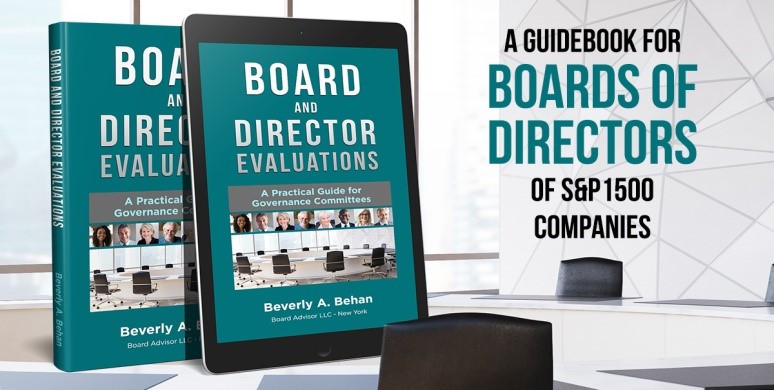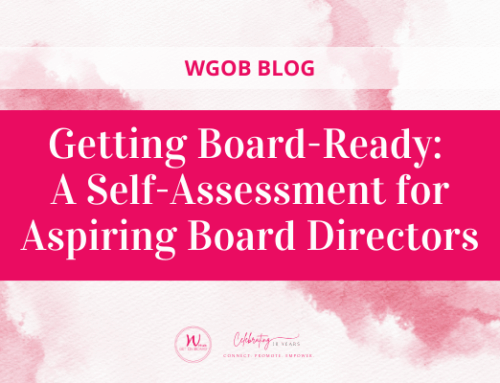Women Get On Board is a member-based company that connects, promotes, and empowers women to corporate boards. That’s why we’ve launched our very first Women Get On Board Virtual Speaker Series, focused on topics that are essential for boards to be more effective in their roles.
To kick off this series, our Founder & CEO Deborah Rosati introduced Beverly Behan, President of Board Advisor LLC. Beverly advises Boards of Directors of S&P 1500 companies and other boards of listed companies around the world and is an expert on board and director evaluations. Her upcoming book, Board and Director Evaluations, a Practical Guide for Governance Committees, will be released on Amazon later this year.

All participants in the session received a PDF Advance Reader Copy of the new book.
“Most directors want to be on a great board. Most chairs want to lead a great board. CEOs and executive teams want to work with a great board,” said Beverly. “Yet board evaluations continue to be an under leveraged tool.”
What’s the solution? How can you make sure your board is functioning at the top of its game? Beverly says the key is effective evaluations. We have summarized her key points on this issue for you below:
- Effective Board Evaluations
- Board 2.0
- Board Benchmarking
- Director Evaluations
- New Director 360
- Effective Board Evaluations
Beverly said that the number one factor in effective board evaluation is having a boardroom champion – someone in a leadership position, either Board Chair, Chair of the Governance Committee or even a Chief Executive Officer who genuinely wants to create an outstanding board. If a champion realizes that the board isn’t at the top of its game he/she wants to make changes. A boardroom champion wants the company’s executive team to genuinely consider the board one of the company’s major assets. Often, women are excellent boardroom champions.
By contrast, some board leaders are self-preservationists who largely relish the prestige of being on a board, particularly serving as Chair of the Board or Governance Committee. They are typically not open to evaluation processes that might be threatening their position. They are comfortable with mediocrity if it means self-preservation and, unlike boardroom champions, are not inspired by excellence but largely by doing whatever it takes to continue their tenure on the board.
Effective board evaluations require structured, confidential interviews tailored to the real issues impacting every board; survey formats simply don’t elicit this type of constructive, actionable feedback nor leverage directors’ good ideas and valuable insights. Beverly noted that one of the things boards that use surveys miss out on are the genuinely good insights of talented sophisticated directors. Interviews with members of the senior executive team who regularly attend board meetings should also be included. Zoom can be an excellent vehicle to conduct the interviews. Every three years, a third party should be retained to facilitate the board evaluation, consistent with UK best practice.
Board Evaluation Feedback is analyzed and summarized into a report of about 10 pages. The report is typically shared in pre-reading to a board meeting where the full board discusses the outcomes and creates an Action Plan summarizing initiatives the board decides to take as an outcome of the Evaluation.
- Board 2.0
Beverly introduced the concept of Board 2.0 – an exercise that engages all board members and senior executives in the design of the optimal board composition to govern the company in 3-5 years. Originally developed for boards undergoing significant transitions (mergers, IPOs, major change in business/strategy requiring change in board composition), the exercise can be incorporated into a board evaluation. Every Board 2.0 design will differ–and should reflect the company’s business model, corporate strategy, stage of growth, and ownership structure.
Once developed, Beverly recommends factoring in diversity objectives for optimal Board 2.0 composition through director selection, recognizing and factoring in the reality that talent pools for diversity candidates are richer in some areas than others. She felt that earmarking a “diversity seat” on Board 2.0 had a negative undercurrent of marginalization. Her view was that directors who serve to diversify the board must become a core part of the governance team. Personal qualities/characteristics such as integrity, commitment, etc. are also important factors to be considered in director selection.
- Board Benchmarking
A useful supplement to any discussion around board composition can be a board benchmarking study. This analyzes the makeup of your board relative to a peer group of boards in similar industries that are compensated similarly; many boards use the peer group developed for executive compensation for this purpose.
This analysis is not to imply that your board should look like the boards of your peer companies, but rather give insight on the backgrounds/expertise of directors serving on your competitors’ boards–always an illuminating exercise. On top of skills and experience, you can use board benchmarking to conduct a diversity analysis, in which you look at female directors or ethnic minorities as well as policy analysis on issues such as retirement policies, directors having to submit their retirement on a change of primary employment, etc.
- Director Evaluations
Some boards incorporate a director evaluation into an upgraded, interview-based board evaluation. But if the board is faced with a limited budget or other issues that prevent doing both, Beverly recommended that the board invest first in upgrading its board evaluation before implementing a director evaluation process as this typically yields greater returns.
According to a recent U.S. survey conducted by PricewaterhouseCoopers, nearly half of the board members surveyed said that one of their fellow directors needed to be replaced. This underscores issues that many boards have with director performance management. Director evaluations can help to address these problems constructively, particularly if the primary issue is a behavioral one–lack of preparation, micro-management, taking an abrasive tone in challenging management etc. If the real problem is that the director has the wrong background to make a meaningful contribution in the boardroom, a Board 2.0 exercise may be more useful in getting to the heart of that issue.
Beverly said that director evaluations should give specific, constructive, and balanced feedback. Every single director has something that they’ve probably done well and something they need to improve on. Most people respond well to this type feedback rather than scores and generalities. If you find there are many problems with a specific director, it’s still important to acknowledge the good in order to have a constructive conversation surrounding improvement. Most of the time, directors given critical feedback will try to change their behavior. Sometimes, however, directors will resign or need to be removed—and that’s not necessarily a bad thing.
- New Director 360
This is a new concept developed from Beverly’s work with a Fortune 100 company last year which had just recruited some very experienced and sophisticated new board members and wanted to upgrade their director evaluation process – and take into account that these board members were new. The New Director 360 is a 360-degree process to provide constructive feedback to new directors who have joined a board within 12 to 18 months.
The 360-review typically includes interviewing all board members, the CEO and other corporate executives who regularly attend board meetings, and even the external auditor and compensation consultant. These conversations are developmental as well as evaluative. The New Director 360 accomplishes three things. First, it reinforces the new directors perceived strengths/contributions – which is very much appreciated by new board members. Second, it can nip any performance issues in the bud. Third, advice is offered – often very innovative suggestions – that can help each new director continue their professional development as a member of the board, whether that involves sites visits, meetings with particular members of the management team, certain conferences to attend or courses to consider etc.
The New Director 360 may be a useful final component of a Director Orientation Program – even for boards that do not otherwise conduct director evaluations.
Interested in learning more about effective boards and governance? Join us for our next Women Get On Board Virtual Speaker Series on October 5th about Board Composition and Renewal. The session will feature Cathy Logue, FCPA, FCA, Managing Director, Global Practice Leader, CFO & Private Equity of Stanton Chase as well as, Deborah Rosati, FCPA, FCA, ICD.D, Corporate Director & Founder and CEO of Women Get On Board. Register here.
–
By: Rachel Collier






